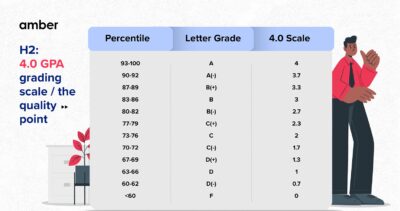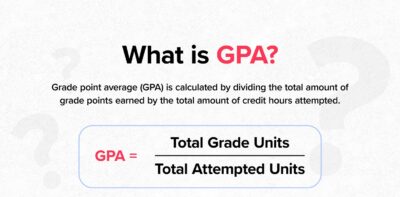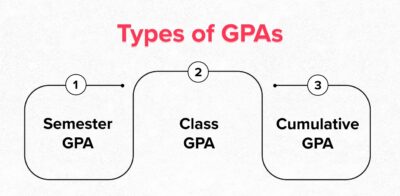One of the first things students must figure out when considering education in the United States is decoding the US grading system. It is one of the most important aspects of academic assessment and has a nuanced approach to evaluating students. With this blog, you can discover the intricacies of the American grading system, discussing various types of grades, the significance of the Grade Point Average (GPA), the realm of honors, and how the US grading system contrasts with the UK Grading system. Let’s begin by understanding what the US grading system consists of!
An Overview of the US Grading System
Although one might already be acquainted with the grading system, the education industry follows it. Typically, students’ academics are evaluated by marks, which are displayed as grades or percentages, but the American grading system is not as similar as it seems.
The American grading system is a composition of GPA (Grade Point Average) to evaluate academic performance. The GPA system is obeyed for all levels of education in the country, and one of the widely used types of GPAs is the 4-point grading system.
What are the Types of US Grading Systems?
Getting acquainted with the American grading system will be the first step to learning how to ace your exams. In the US, there are two different grading systems: the numerical system and the alphabetical system. Here is a quick and easy breakdown of the different types of grading systems and different grades in the USA.
1. Numerical US Grading System
The numerical approach of the US grading system is fairly straightforward to understand. These grades in the USA mark students on a numbered scale pre-decided by their university or school. Depending upon how well they do, they will receive a numbered grade to assess their performance. For example, you could be scored on a percentage system and be given a grade anywhere from 0 to 100%.
2. Letter US Grading System
Letter grades in the USA are obtained by students in routine tests or term exams, such as A, B, and C. This system is also known as the A-F grading system. Every letter grade denotes a student’s numerical performance by a number. Students can further convert the grade into a GPA. Here is a basic breakdown of the meaning of each letter in the American grade system.

3. Special Grades
The US grading system also incorporates a few different letter grades into the American grading scale. These do not exactly denote your grades but instead are used to highlight the status of your course. However, these still show up on your transcript in the American grade system. So, to ensure that these random letters on your mark sheet don’t confuse you, here is what they mean in the American grading scale:
A. IP
IP is an acronym for ‘In Progress. If students haven’t finished parts of a subject within the stipulated time to earn the regular grade, they will probably be given this grade. Upon completion, this grade is converted to the regular grade.
B. NC
In the US grading scale, NC stands for ‘Not Complete’. If a task or homework assigned to a student is not complete or the student fails to complete the same, then this grade is given to the student on the transcript.
C. W
W in the US grading scale means ‘withdrawn’. This grade is awarded to students who are present or attend classes but drop out midway.
How are Letters and Numerical Systems Related?
Every letter grade corresponds to a number or percentage, which is then used to calculate your GPA. Your numerical grade is used to obtain your letter grade. Each college will have its exact denotation of which grade corresponds to what letter, but here is a general breakdown of the different letter grades and their corresponding grade range. In the United States, academic performance is evaluated using 5, 6, to 7-letter grades. The conventional grading scale includes A+, A, A-, B+, B-, B-, C+, C-, D+, D, D- and F, with A+ being the highest grade and F being the lowest. Here is a quick and easy breakdown of the US grading systems.

What is Grade Point Average (GPA)?
GPA, or Grade Point Average, is the primary marking system of the US grading system. Your GPA, as the name suggests, is the overall average of all your grades for a specific time period. For a full breakdown, check out our detailed guide on what is GPA and how to calculate it.
Here’s how the GPA grading system works:
A = 4.0
B = 3.0
C = 2.0
D = 1.0
F = 0.0
How to Calculate GPA?
In the US grading system, the aggregate quality points gained in each unit are added to calculate GPA. The final result is divided by the total number of course credits or units (or credit hours) you attempted to arrive at your average GPA. It is not just the average of all your grades but determines your final GPA at graduation. The amount of semester hours determines how much weight it has. To get a better understanding of how your final grades will be calculated, you can also read our blog on how to improve your GPA.
For example: GPA = Total Grade Points / total number of credit hours or courses taken. Therefore, if your total grade points are 22 and the number of classes you took is 6, then, your GPA would be 3.6.

Types of GPA
Now that we’ve covered grades and how they’re represented in the US grading system, let’s look at another crucial aspect of the new grading system: the GPA. The Grade Point Average (GPA) is a grading system in USA which is used throughout to describe students’ performance. It is divided into three categories that represent different levels of study. The three categories are:
1. Class GPA
This GPA focuses on a specific set of courses, like all your math classes in a semester. It tells you how well you did in those particular subjects.
2. Semester GPA
This GPA looks at your performance for an entire semester or quarter. It considers all the grades you earned during that period, giving you an idea of your overall performance.
3. Cumulative GPA
This is the big one! It takes into account all your grades throughout your academic career from the very beginning. This gives colleges and universities a broader picture of your academic achievements.
Here are some extracurricular activities that can help enhance your overall GPA:
- Student organizations
- Community service
- Internships
- Study groups
In the U.S. education system, engaging in these extracurricular activities can positively impact your GPA. Therefore, choose activities that interest you and can contribute to your academic success.

Honours and Its Types
Students who meet the requirements for any level of study may receive a gratuitous honour based on their GPA. Based on other prerequisites, honours can differ from university to university. The Latin language is used for all distinctions. Relevantly, the student with a better GPA will automatically be given all three honours. They are:
1. Cum Laude: With Honour
Cum laude, which in Latin means “with acclaim” or “with honour,” denotes a certain level of academic success. Educational institutions use the phrase to describe an academic degree given to someone with honourable distinction in academic courses.
2. Magna Cum Laude: With Great Honor
Students who graduate “with great distinction” are given the honorific Magna cum laude. In terms of Latin honours, it is the second-highest. The qualifications differ by institution, but it’s often reserved for students who rank in the top 6–15% of their class or who have a GPA of 3.7–3.8.
3. Summa Cum Laude: With Greatest Honour
The greatest academic honour, summa cum laude, which translates to “with the highest honour,” is given to pupils who rank in the top one percent of their class or who have a GPA of 3.9 to 4.0. The prerequisites for summa cum laude can differ by institution and department, just as the magna cum laude distinction. If you want to have one of these honours plastered on your degree, it’s time to learn how to improve your GPA!
What are the degree classifications in the US?
In the US, degrees are classified into three types:
- First class honours: 70% and above
- Upper Second class honours: 60% – 70%
- Third class honours: 40% – 50%
Scoring below 40% means you have not passed your degree while scoring above 70% means you have achieved a high classification. Your GPA represents your final grade. If you score between 90% – 100%, your GPA will be 4.0. Anything below 60% is considered a failure in the US.
What is the Difference Between UK and US Grading Systems?
The UK grading system uses a class grade order, unlike most grading systems, including the US one, which uses the alphabet to show the student’s accomplishments. This system mirrors the paradigm of the British class system and dates back to the institution’s founding. The UK utilizes letter grades similar to the American grading system, although not in the same way. In the UK, an “A” is defined as anything above 70% rather than each letter denoting 10%. Every additional letter results in a 10% reduction. To know more about this, refer to our detailed guide on the UK grading system, which will help you acknowledge all the aspects of this system.

That was our full breakdown of the American grading system. While the US grading system isn’t too hard to understand, adjusting to a new structure can be tough, so we’ve tried to make your transition as smooth as possible. We hope you’ve found this blog helpful and wish you all the best on your student journey! Also, if you are planning to move to the USA, you must be worried about finding ideal housing. Don’t worry; we provide some amazing options for student housing in the US to make your path less stressful.
